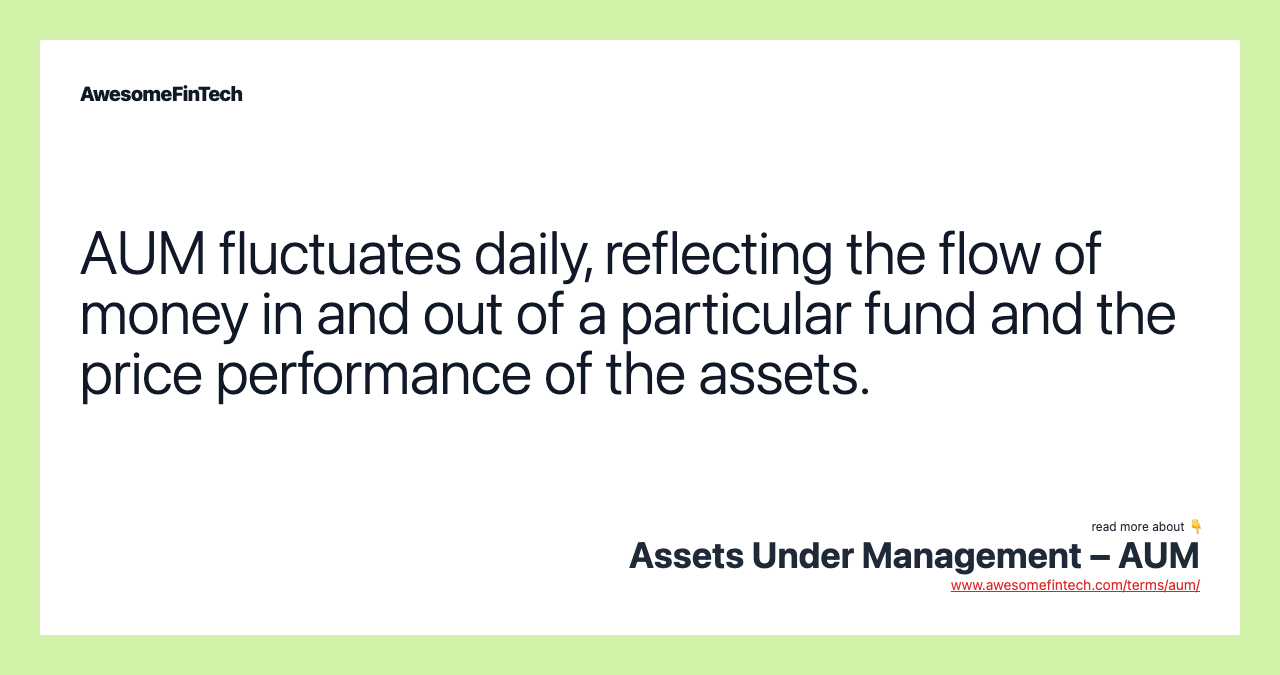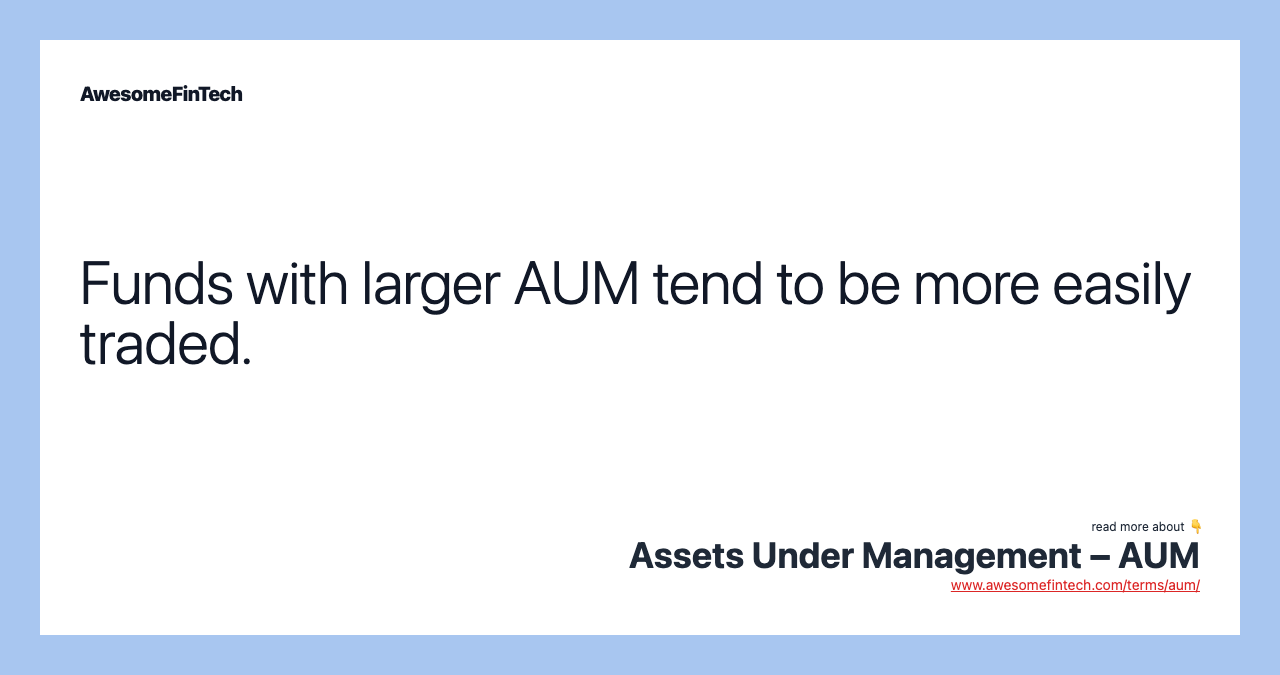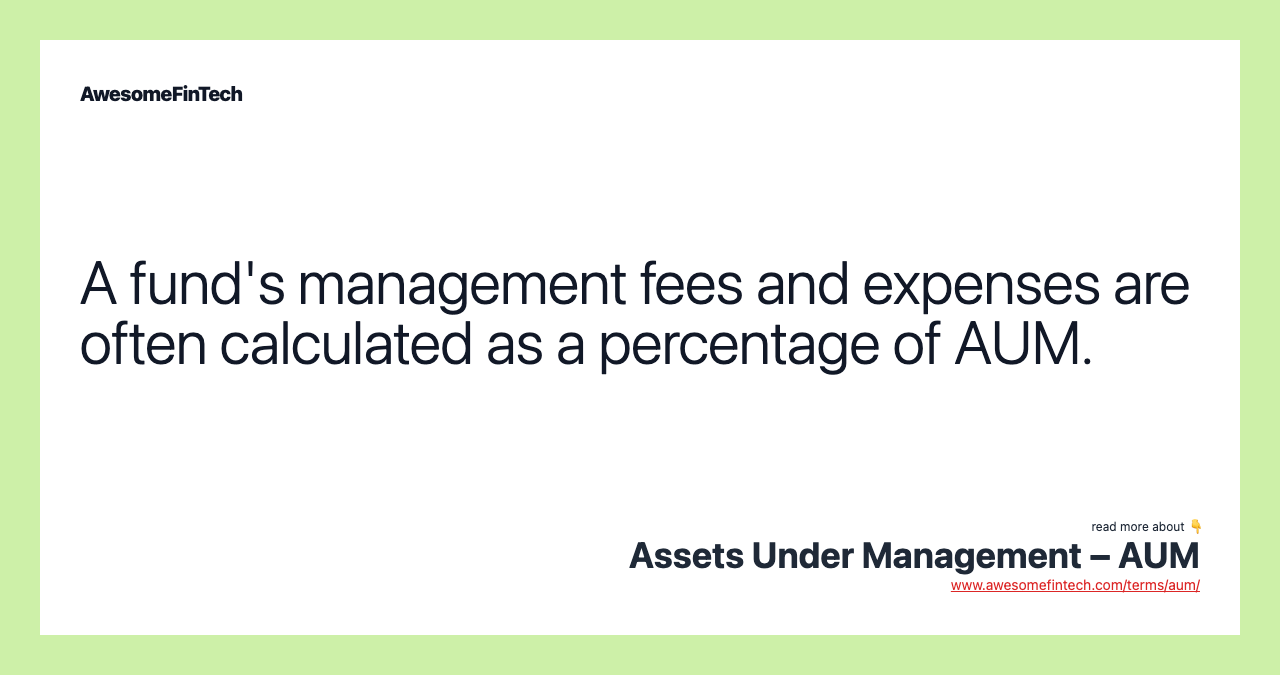Assets Under Management – AUM
Assets under management (AUM) is the total market value of the investments that a person or entity manages on behalf of clients. AUM is the sum of the market value for all of the investments managed by a fund or family of funds, a venture capital firm, brokerage company, or an individual registered as an investment advisor or portfolio manager. Used to indicate the size or amount, AUM can be segregated in many ways. Factors causing decreases in AUM include decreases in market value from investment performance losses, fund closures, and a decrease in investor flows. Assets under management (AUM) is the total market value of the investments that a person or entity handles on behalf of investors. Assets under management (AUM) is the total market value of the investments that a person or entity manages on behalf of clients.

What Are Assets Under Management (AUM)?
Assets under management (AUM) is the total market value of the investments that a person or entity manages on behalf of clients. Assets under management definitions and formulas vary by company.
In the calculation of AUM, some financial institutions include bank deposits, mutual funds, and cash in their calculations. Others limit it to funds under discretionary management, where the investor assigns authority to the company to trade on their behalf.
Overall, AUM is only one aspect used in evaluating a company or investment. It is also usually considered in conjunction with management performance and management experience. However, investors often consider higher investment inflows and higher AUM comparisons as a positive indicator of quality and management experience.




Understanding Assets Under Management
Assets under management refers to how much money a hedge fund or financial institution is managing for their clients. AUM is the sum of the market value for all of the investments managed by a fund or family of funds, a venture capital firm, brokerage company, or an individual registered as an investment advisor or portfolio manager.
Used to indicate the size or amount, AUM can be segregated in many ways. It can refer to the total amount of assets managed for all clients, or it can refer to the total assets managed for a specific client. AUM includes the capital the manager can use to make transactions for one or all clients, usually on a discretionary basis.
For example, if an investor has $50,000 invested in a mutual fund, those funds become part of the total AUM — the pool of funds. The fund manager can buy and sell shares following the fund's investment objective using all of the invested funds without obtaining any additional special permissions.
Within the wealth management industry, some investment managers may have requirements based on AUM. In other words, an investor may need a minimum amount of personal AUM for that investor to be qualified for a certain type of investment, such as a hedge fund. Wealth managers want to ensure the client can withstand adverse markets without taking too large of a financial hit. An investor’s individual AUM can also be a factor in determining the type of services received from a financial advisor or brokerage company. In some cases, individual assets under management may also coincide with an individual's net worth.
Calculating Assets Under Management
Methods of calculating assets under management vary among companies. Assets under management depends on the flow of investor money in and out of a particular fund and as a result, can fluctuate daily. Also, asset performance, capital appreciation, and reinvested dividends will all increase the AUM of a fund. Also, total firm assets under management can increase when new customers and their assets are acquired.
Factors causing decreases in AUM include decreases in market value from investment performance losses, fund closures, and a decrease in investor flows. Assets under management can be limited to all of the investor capital invested across all of the firm’s products, or it can include capital owned by the investment company executives.
In the United States, the Securities and Exchange Commission (SEC) has AUM requirements for funds and investment firms in which they must register with the SEC. The SEC is responsible for regulating the financial markets to ensure that it functions in a fair and orderly manner. The SEC requirement for registration can range between $25 million to $110 million in AUM, depending on several factors, including the size and location of the firm.
Why AUM Matters
Firm management will monitor AUM as it relates to investment strategy and investor product flows in determining the strength of the company. Investment companies also use assets under management as a marketing tool to attract new investors. AUM can help investors get an indication of the size of a company's operations relative to its competitors.
AUM may also be an important consideration for the calculation of fees. Many investment products charge management fees that are a fixed percentage of assets under management. Also, many financial advisors and personal money managers charge clients a percentage of their total assets under management. Typically, this percentage decreases as the AUM increases; in this way, these financial professionals can attract high-wealth investors.
Real-Life Examples of Assets Under Management
When evaluating a specific fund, investors often look at its AUM since it functions as an indication of the size of the fund. Typically, investment products with high AUMs have higher market trading volumes making them more liquid, meaning investors can buy and sell the fund with ease.
For example, the SPDR S&P 500 ETF (SPY) is one of the largest equity exchange-traded funds on the market. An ETF is a fund that contains a number of stocks or securities that match or mirror an index, such as the S&P 500. The SPY has all 500 of the stocks in the S&P 500 index.
As of August 15, 2020, the SPY had assets under management of $300 billion with an average daily trading volume of 51 million shares. The high trading volume means liquidity is not a factor for investors when seeking to buy or sell their shares of the ETF.
The First Trust Dow 30 Equal Weight ETF (EDOW) tracks the 30 stocks in the Dow Jones Industrial Average (DJIA). The EDOW has assets under management of $37 million and much lower trading volume compared to the SPY, averaging nearly 3,000 shares per day. Liquidity for this fund could be a consideration for investors, meaning it could be difficult to buy and sell shares at certain times of the day or week.
Related terms:
Asset Management Company (AMC)
An asset management company (AMC) invests pooled funds from clients into a variety of securities and assets. read more
Asset Performance
Asset performance refers to a business's ability to take operational resources, manage them, and produce profitable returns. read more
Dow Jones Industrial Average (DJIA)
The Dow Jones Industrial Average (DJIA) is a popular stock market index that tracks 30 U.S. blue-chip stocks. read more
Exchange Traded Fund (ETF) and Overview
An exchange traded fund (ETF) is a basket of securities that tracks an underlying index. ETFs can contain investments such as stocks and bonds. read more
Financial Advisor
What does a financial advisor do? Read our complete guide before hiring a financial advisor to ensure that you choose the best financial advisor for your specific needs. read more
Hedge Fund
A hedge fund is an actively managed investment pool whose managers may use risky or esoteric investment choices in search of outsized returns. read more
Investment Advisers Act of 1940
The Investment Advisers Act of 1940 is a U.S. federal law that defines the role and responsibilities of an investment advisor/adviser. read more
Investment Manager
An investment manager is a person or organization that makes investments in security portfolios on behalf of clients. read more
Liquidity
Liquidity refers to the ease with which an asset, or security, can be converted into ready cash without affecting its market price. read more
Managed Account
A managed account is an investment account that is owned by one investor but is overseen by a professional money manager or management firm. read more